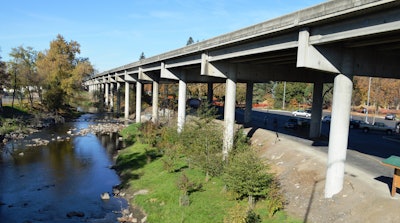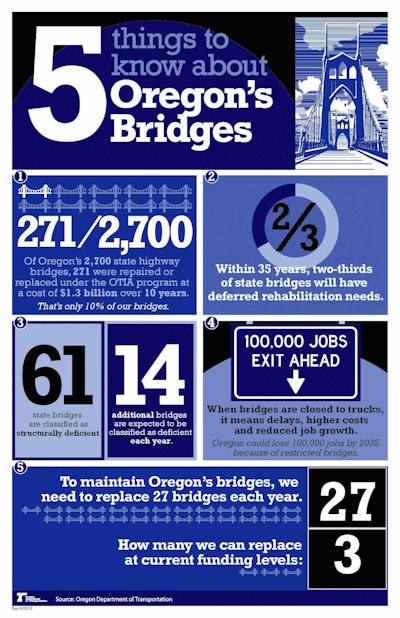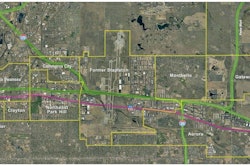 Interstate 5, Medford Viaduct opened in 1962.
Interstate 5, Medford Viaduct opened in 1962.The Oregon Department of Transportation (ODOT) is painting a grim picture of the economic impact on the state with current bridge funding and maintenance programs, estimating $94 billion in lost production value and a loss of 100,000 jobs over a 20-year period.
The department’s 2015 Bridge Condition Report provides an overview of bridge conditions across the state using the National Bridge Inventory and its own data supplied to the Federal Highway Administration. The most recent data was supplied in April this year.
“Healthy bridges are critical to Oregon’s economy and our lifestyle,” ODOT Director Matthew Garrett said. “They connect communities; they link lives. We cannot let those bonds break. We must be willing to make the necessary strategic investments.”
ODOT’s report does indicate the state’s bridge system as a whole is improving. Through 2014 via the 2003 Oregon Transportation Investment Act (OTIA III) State Bridge Delivery Program, 122 bridges in the state’s highway network have been repaired with another 149 being replaced.
 5 Things to know about Oregon’s Bridges
5 Things to know about Oregon’s BridgesThrough this year, 79 percent of Oregon bridges on state highways, 86 percent on interstate highways and 79 percent on the National Highway System are not considered distressed. The state highway system has 2,727 bridges, with cities and counties having roughly 4,000.
But ODOT is quick to point out in the report that OTIA III was a temporary “catch-up” program and that the state is facing a problem of aging bridges combined with reduced transportation funding.
Currently, more than have of the state’s bridges were built before 1970. By 2020, 57 percent will be considered to be at the end of their design lives. ODOT of that figure, 18 percent are “one point away from structural deficiency”. About 14 bridges a year fall into structurally deficient condition now, but by 2020 ODOT expects that rate to increase to 70 per year.
“If these bridges were people, we’d be throwing retirement parties for them,” Oregon State Bridge Engineer Bruce Johnson said. “Instead, we’re asking them to carry more traffic at higher speeds and heavier weights.”
To stress the need for increased transportation funding, ODOT says that replaced each state highway bridge on a “100-year cycle” would entail replacing 27 bridges each year. The current funding covers about three per year. Major maintenance on bridges should occur every 30 to 50 years, the department says, but funding today only finances major maintenance at a rate of once every 100 years.
“Without the funding to proactively address bridge needs to prevent problems before they occur, we are forced to react to problems after they occur,” Garrett added. “Patching holes in decks and making emergency fixes to bridges is not a strategic use of taxpayer money, and is very inconvenient to all travelers. Strategic investment to repair or replace older bridges in a coordinated manner protects our economy; minimizes detours, delays and traveler inconvenience; and keeps Oregon moving well into the future.”
The full 2015 Bridge Condition Report is available here, and an interactive map of Oregon’s bridges is located here.
This video shows an inspection of the Marquam Bridge that crosses the Willamette River in Portland.














